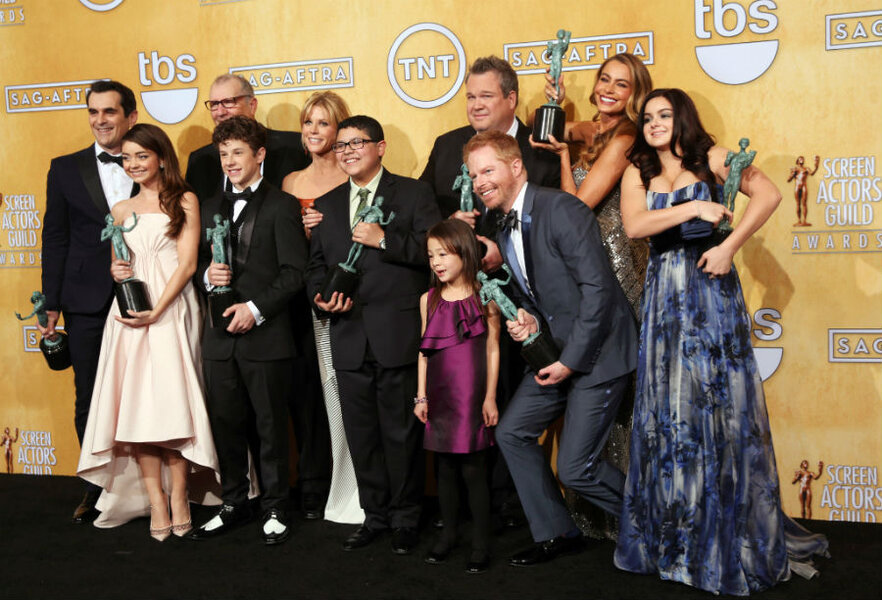What does the first transgender child actor mean for TV casting?
Loading...
After grappling with sensitive issues such as sexual orientation, race, and blended families for more than seven seasons, ABC’s "Modern Family" will feature an openly transgender child actor this fall.
Ryan Case, one of the award-winning show's directors, announced that 8-year-old Jackson Millarker, a transgender boy, will appear as a guest actor in an episode slated to air Wednesday night.
“This is Jackson Millarker,” Ms. Case wrote in an Instagram post. “He’s 8 years old, from Atlanta, and just happens to be transgender. He plays Lily’s friend Tom in this week’s Modern Family and he’s wonderful. One of the many reasons I love being a part of this show.”
As transgender issues and culture have become more high profile, mainstream media has woven a growing number of fictional transgender characters into narratives. The problem, in the eyes of some LGBT advocates, is that many of these characters have been played by actors who are cisgender, meaning that their gender identity conforms to their sex at birth. Many have taken on roles that show transgender people as little more than a stereotype, activists argue, reducing a transgender woman to a "man in a dress" and simplifying the complexities of trans identity.
From Jared Leto’s Oscar-award winning role as a transgender woman in "Dallas Buyers Club," to Jeffrey Tambor’s portrayal of an older man transitioning to become a woman in the Amazon series "Transparent," critics have decried what some call "transface," a concept similar to white-washing: casting mainstream, cisgender actors to play transgender characters, rather than searching for trans talent.
“Television, of course, doesn’t really hold up a very accurate mirror to any group,” Bruce Drushel, an associate professor of media and culture at the University of Miami, tells The Christian Science Monitor. “And certainly never has, to gay and lesbian characters, or bisexual characters, or transgender characters.”
That is evident in the lack of transgender actors taking on roles that represent their own community. Two years ago, when an interviewer questioned "Dallas Buyers Club" director Jean-Marc Vallée about his decision to cast Mr. Leto's character, he told CBS Radio that he had "never" considered hiring a transgender actor.
“Is there any transgender actor?” he said. “To my knowledge, I don’t know one.”
That lack of awareness is typical, many activists say.
"Having the opportunity to play positive roles seems slim for trans actors when I look at the abysmal lack of confidence and intestinal fortitude of Hollywood," Fallon Fox, a transgender professional Mixed Martial Arts fighter, wrote in an essay about Leto's casting. "I can't be the only one to have dreamed of such uplifting opportunities for our community. But that will never happen if no one sheds light on the absence of trans actors and no one dares to challenge the absence of trans actors and the unequivocal celebration of cis actors in trans roles."
Some say there has been progress just since Leto took home the Best Supporting Actor award in 2014. Transgender actress Laverne Cox has received praise for her role in "Netflix’s Orange is the New Black," and "Transparent" recently featured a 12-year-old transgender actress.
Just last week, that show's star, Mr. Tambor, called for Hollywood to become more inclusive.
"Give them auditions. Give them their story. Do that," he said last week while accepting an Emmy award for his role in "Transparent." "I would not be unhappy if I were the last cisgender male to play a female transgender on television. We have work to do."
"Modern Family," a show which has brought a variety of once controversial topics to a mainstream, family-friendly audience, has done just that.
"Particularly having an actor, a young actor, who identifies as transgender, I would say is groundbreaking," Dr. Drushel says. "One reason is that we really haven't had very many transgender roles being played by transgender actors. To have one so young I think is going to give new visibility to a phenomenon that most people are not aware is happening."
Thirty percent of Americans know someone who is transgender, according to a Pew Research poll released on Tuesday. Many LGBT advocates, then, see portrayals of transgender people in the media as especially important for shaping the public's understanding of transgenderism. In the few shows that do feature transgender characters, many come out as transgender later in life, perhaps leading some viewers to assume that is always the case. By introducing audiences to a young person who identifies as transgender, "Modern Family" would be presenting a different point of view.
Still, the media is still far from normalizing such roles – and not just for transgender characters or actors. Some LGBT celebrities, like Ellen DeGeneres, have achieved fame that shifts public attention from their sexual orientation or gender identity to their talent and personality traits. Many LGBT characters, however, are brought into narratives that place emphasis on the circumstances surrounding their identity, and it can be difficult to introduce them without making some kind of statement.
"Even though we are seeing more and more lesbian and gay characters in television, and increasingly now transgender characters, I don't think we're to the point that nobody is going to say, 'Oh, that's a trans woman,' " Drushels says. "Even if the narrative doesn't play up the identity, I think it's still going to be in the minds of the viewers that it's something unusual, something different. Transgender is something close to the last frontier when it comes to cultural acceptance."








